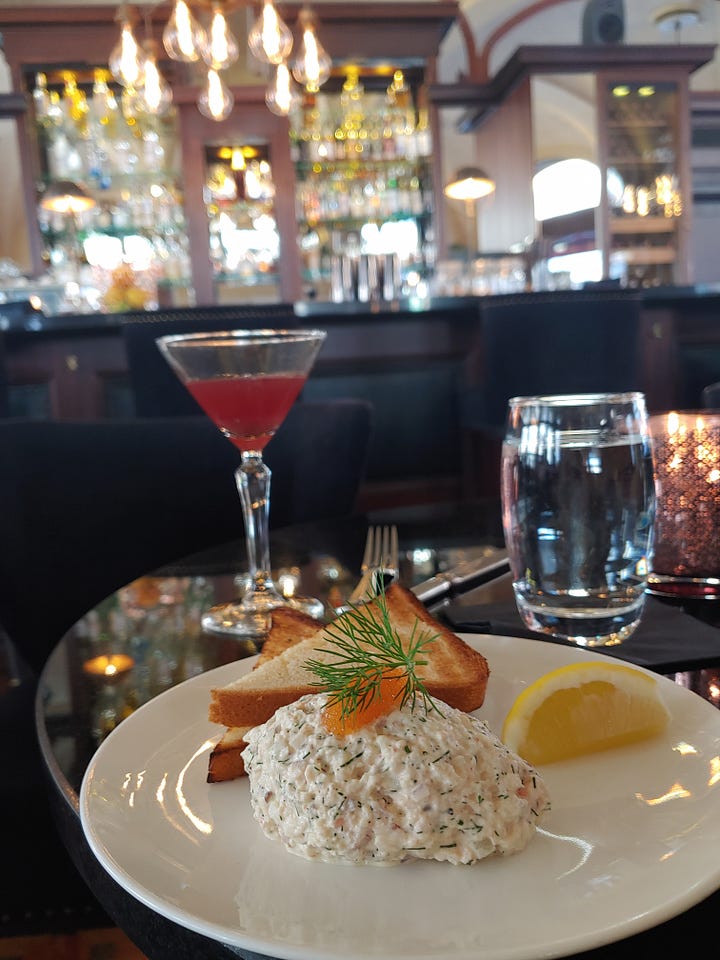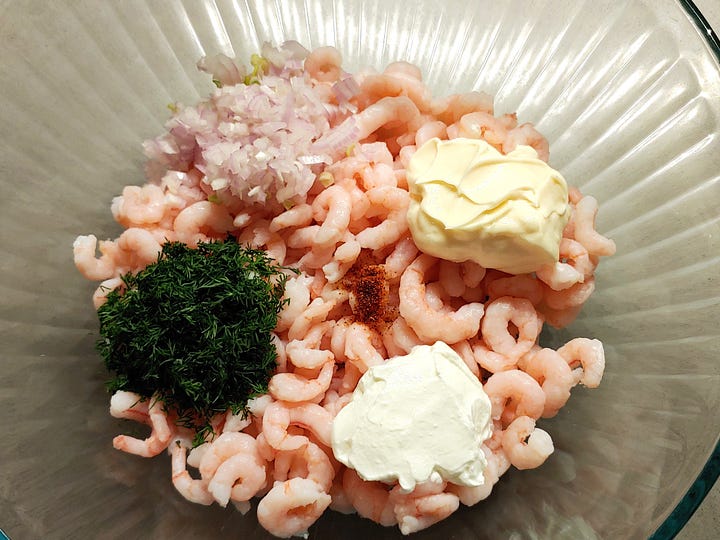I’m back up in the mountains this week, teaching some classes at the Sun Valley Culinary Institute in Ketchum, Idaho, as I’d mentioned in this earlier issue: one a focus on butter, the other all about oysters. I’ll share one recipe from the butter class later, among them is a salmon recipe with a beurre rouge—a red wine variation on the classic butter sauce beurre blanc made with white wine. Such elegant, rich butter sauces might seem intimidating to prepare but really are rather easy with just a couple things to keep in mind. I’ll loop back on that soon.
As for the oyster class, that’s a topic about which I’ve already shared a lot about here in these last couple of years, and more to come on them as well. To cover some bases of technique in the class tomorrow—as much as one can in a couple of hours—I’m teaching a mignonette to accompany half-shell oysters, baking oysters in the shell with a lightly spiced “devil” sauce, showcasing very good smoked oysters in a simple crostini and pan-frying oysters, which I’ve made clear in previous issues is one of my all-time favorite oyster preparations. I walked readers through that process, which has plenty of room for flexibility, in this earlier issue.
One last note about butter (well, last for this newsletter at least…far from last butter-related note I’ll be sharing with you!), I meant to include this link from a New York Times article early November about what they found to be the best butters after a detailed testing. I was happy to see that the two butters regularly on hand at my house made the list: Kerrygold salted and Kirkland Signature unsalted. The Beurre d’Isigny with sea salt crystals was part of a butter tasting we did in the class last night, along with Tillamook unsalted, Parma unsalted, and Kerrygold salted. Those four butters alone were a great example of how varied the options are out there. It’s such a delicious and versatile ingredient to experiment with.
Today’s issue will be a bit briefer, given it’s a travel week and I’m tied up with teaching a few classes. I’ve been meaning to share this recipe below for some time, following a recent trip that included my first ever visit to Oslo. I just realized this makes the fourth shrimp recipe I’ve shared in the past three or four newsletters. I’ll work to mix it up more—though shrimp is super popular for a reason. Broadly loved and super versatile!
Speaking of which, if there’s a type of seafood you’d like to hear more about from me, or are particularly interested in having some recipe ideas for, please let me know down in the comments!


Oslo Inspired Shrimp Salad
This is my best stab at recreating a treat from a visit to the gorgeous Theatrecafeen restaurant in Oslo spring of 2023. The other item we had there was outstanding as well, a tahini dip with gorgeous red endive leaves for scooping. And their cocktails were spot-on too, it was an all-around great experience. We opted for a seat in the bar area for a couple light bites, on another trip I’d love to have a dinner in the main dining room.
A dear friend who lives in Oslo had recommended we go to that restaurant—here’s to you, Scott, thanks so much for the suggestion! When I later asked him for input about how he thought the shrimp salad may have been made, he confirmed my initial inkling that it was likely composed of not much more than bay shrimp, minced shallot, fresh dill, and some lemon juice.
As for the binding, I let him know that I couldn’t recall the flavor well enough to guess whether it was mayonnaise, or maybe sour cream instead? His recommendation was a ratio of about 2/3 mayo and 1/3 crème fraîche (ideally, it has bit richer flavor than sour cream; I already had sour cream in the fridge so used that instead for this testing). Plus, a pinch of cayenne “to kick it up” as he said.
As you’ll note in the photos above, this shrimp salad was served rather elegantly: neatly shaped, topped with roe and served with lightly toasted slices of simple white bread. I took a short cut and served my re-creation of the salad with crackers. Whatever sounds good or works well for you, from various toast options (brioche would be another lovely option) or crackers to even in an endive leaf or simply as is in a small dish—there are plenty of options for serving this delightful salad.
In the restaurant’s salad the shrimp were rather finely chopped, surely to make spreading onto the toasts a bit easier. You can certainly do the same, for this version of the recipe below I left those tiny shrimp whole. Chopping also makes using larger cooked shrimp and option, if you’re unable to find good bay shrimp available.


12 ounces cooked bay shrimp
2 tablespoons minced shallot
1 to 2 tablespoons minced fresh dill (to your own taste), plus sprigs for garnish
3 tablespoons mayonnaise
2 tablespoon crème fraîche or sour cream
1 tablespoon freshly squeezed lemon juice
Pinch cayenne (optional)
Kosher salt
Toasted bread or crackers, for serving
Drain the shrimp on paper towels if they’re at all wet, for best texture of the finished salad. If you prefer a finer texture for the salad, chop the shrimp. Put the shrimp in a medium bowl and add the shallot, minced dill, mayonnaise, crème fraiche, lemon juice, and cayenne, if using. Stir gently until well and evenly blended. Taste and stir in a bit of salt if needed. Cover the bowl and refrigerate for an hour or two before serving, so the flavors will blend a bit.
To serve, spoon some of the shrimp salad onto individual plates, with toasted bread or crackers alongside. Or, for a party, transfer the shrimp salad to a serving bowl and set on a plate surrounded by toasted bread or crackers.
Makes about 2 cups, 4 to 6 servings or so





I am making this salad in the hope that it will transport me back to Oslo and the fabulous Theatrecafeen, so many memories from so long ago.